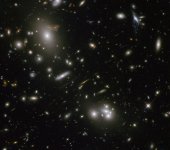SLD
Contributor
Abell 68 was imaged a few years ago by the Hubble. It shows a strange alien looking double image of a galaxy:

The one I the upper left. It looks like an angry alien robot. But the image doesn’t seem to make sense. I would’ve thought that a double image wouldn’t form on one side of the lens only. It seems like the central Galaxy Is pushing light away.
Or is this really a double image, or a merging Galaxy?
What all can these lensing events tell us about the distribution of matter in the foreground cluster? Can it show with more detail the distribution of dark matter vs. ordinary? And if so what exactly have we learned from such?
SLD

The one I the upper left. It looks like an angry alien robot. But the image doesn’t seem to make sense. I would’ve thought that a double image wouldn’t form on one side of the lens only. It seems like the central Galaxy Is pushing light away.
Or is this really a double image, or a merging Galaxy?
What all can these lensing events tell us about the distribution of matter in the foreground cluster? Can it show with more detail the distribution of dark matter vs. ordinary? And if so what exactly have we learned from such?
SLD
